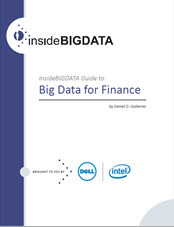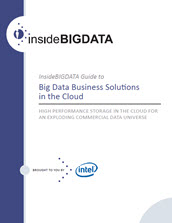Manufacturing concerns consistently have sought ways to reduce waste and variability in their production processes to dramatically improve product quality and yield (e.g. the amount of output per unit of input). Further, these companies need a granular approach toward recognizing and correcting manufacturing process flaws. Big data technology provides just such an approach and many hightier manufacturers possess a significant degree of interest and motivation in adopting the big data technology stack.
InsideBIGDATA Guide to Big Data for Finance
Introduction to Big Data for Finance According to the 2014 IDG Enterprise Big Data research report, companies are intensifying their efforts to derive value through big data initiatives with nearly half (49%) of respondents already implementing big data projects or in the process of doing so in the future. Further, organizations are seeing exponential growth in the amount of data managed with an expected […]
InsideBIGDATA Guide to Big Data Business Solutions in the Cloud
In this Guide, we take a look at what Lustre on infrastructure AWS delivers for a broad community of business and commercial organizations
struggling with the challenge of big data and demanding storage growth. Learn more by downloading this Guide.
Intel Scalable System Framework Facilitates Deep Learning Performance
In this special guest feature, Rob Farber from TechEnablement writes that the Intel Scalable Systems Framework is pushing the boundaries of Machine Learning performance. “machine learning and other data-intensive HPC workloads cannot scale unless the storage filesystem can scale to meet the increased demands for data.”
Adding Security and More to Intel® Enterprise Edition for Lustre* Software version 3.0
Intel Enterprise Edition for Lustre* Software has taken a leap toward greater enterprise capabilities and improved features for HPC with release of version 3.0. This latest version includes new security enhancements, dynamic LNET configuration support, ZFS snapshots, and other features asked for by the HPC community inside and outside the enterprise. Additionally, it adds the Intel Omni-Path Architecture drivers.
Efficiency: Big Data Meets HPC in Financial Services
Converging High Performance Computing (HPC) and Lustre* parallel file systems with Hadoop’s MapReduce for Big Data analytics can eliminate the need for Hadoop’s infrastructure and speeding up the entire analysis. Convergence is a solution of interest for companies with HPC already in their infrastructure, such as the financial services Industry and other industries adopting high performance data analytics.
SGI Deploys over 200 Terabytes in Total Systems Running SAP HANA
Today SGI announced that global deployments of the SGI UV 300H single-node system provide in total over 200 Terabytes of in-memory computing capacity to organizations running the SAP HANA platform. Introduced just one year ago, more than 50 SGI UV 300H systems have been installed in organizations to run a variety of applications on SAP HANA, including the SAP ERP, SAP Supply Chain Management (SCM), SAP Bank Analyzer, and SAP Business Warehouse applications, as well as advanced analytics.
Enabling Value for Converged Commercial HPC and Big Data Infrastructures through Lustre*
A number of industries rely on high-performance computing (HPC) clusters to process massive amounts of data. As these same organizations explore the value of Big Data analytics based on Hadoop, they are realizing the value of converging Hadoop and HPC onto the same cluster rather than scaling out an entirely new Hadoop infrastructure.
Podcast: New Xeons Power Cisco UCS Realtime Analytics
Jim McHugh from Cisco describes how the new Intel Xeon processor E7 v3 processor family will bring to Cisco UCS systems in the big data and analytics arena. He emphasizes how new insights driven by big-data can help businesses become intelligence-driven to create a perpetual and renewable competitive edge within their field.
The Analytics Frontier of the Hadoop Eco-System
“The Hadoop MapReduce framework grew out of an effort to make it easy to express and parallelize simple computations that were routinely performed at Google. It wasn’t long before libraries, like Apache Mahout, were developed to enable matrix factorization, clustering, regression, and other more complex analyses on Hadoop. Now, many of these libraries and their workloads are migrating to Apache Spark because it supports a wider class of applications than MapReduce and is more appropriate for iterative algorithms, interactive processing, and streaming applications.”











